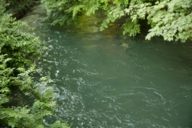
The Auer Mühlbach (river) is roughly seven kilometres long, and is fed from the same Isar water that forges Munich's water supply. What's really special: At the Mondstrasse to the south of the city, he lends the district a certain magical flair.
The area on the corner between Mondstrasse and Vossstrasse is often referred to as Munich's “Little Venice”. At this spot situated below the Giesinger Mountain, the Auer Mühlbach flashes briefly for a few metres at the earth’s surface, before making most of its way through the city back underground.
Here, the world seems to be well in order. People appreciate and enjoy what they have: Idyllic perfection – in the middle of the city. The neighbourhood sticks together, a doorway to a house serves as an exchange point for all sorts of useful and usable items. A tractor is parked in the opposite corner. A pensioner has just jumped into the creek to save some stray ducklings. And, in fact, it is the Auer Mühlbach that helps to create that certain something special.
The scenery is a remnant of the 19th century, when the old town of Munich was once traversed by streams and canals. At that time, the people of Munich used the waters of the Auer Mühlbach as a source of power for mills and forges, as well as to wash clothes and even extinguish fires. It was only later on that the stream became encased, as did many of Munich’s city streams, which became hidden behind concrete ceilings. This is because open streams at that time were primarily seen as a traffic obstruction, a source of danger and a financial burden. The many bridges and walkways had to be maintained. This meant that the streams were sometimes even filled with lean concrete.
Such a shame as people released decades later. Because today people see, above all else, the leisure time and recreational value of streams. The city has also recognised that. In 1981, it commissioned the planning and construction department to develop a concept for the revival of the city's streams: “Surface water ways are of great significance for the city’s ecological balance and the recovery of the population, and are to be conserved and shaped in a way as natural as possible, and even expanded where possible. The water quality must be improved”. (Excerpt from the city's development plan in 1983)
And so came about a gradual rethink. The Greens and other eco-organisations have become increasingly involved. “City streams contribute to the cooling of that well-known phenomenon of a heated island city” explains Wolfgang Heidenreich of Green City e.V. And so, the Auer Mühlbach has once again become a pleasure to behold and enjoy after the removal of its concrete ceilings since the year 2000, as well as on Mondstrasse where residents can even enjoy it in their own back yard.